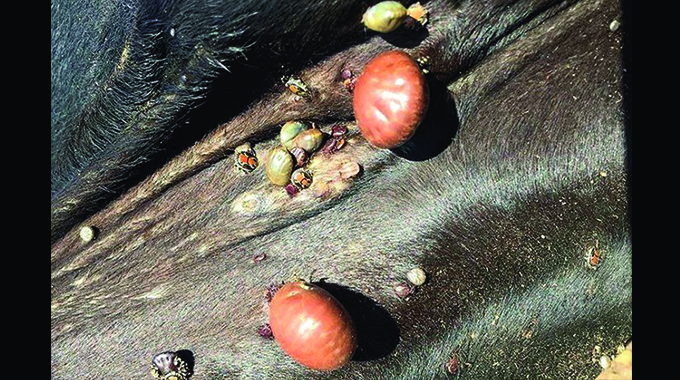
Sikhumbuzo Moyo, smoyo@chronicle.co.zw
MATABELELAND North has been hit by an outbreak of tick-borne diseases with veterinary authorities saying 276 cattle succumbed to the diseases from 525 cases recorded in the province since January.
Hwange, Binga, Lupane and Nkayi districts are the worst affected. The most prevalent tick-borne disease in the province is heartwater, contributing about 60 percent of all reported cases followed by anaplasmosis which accounts for 30 percent and lastly babesiosis.
According to the Department of Veterinary Services, theileriosis (January disease) has not been reported in Matabeleland North although there is a history of corridor disease associated with domesticated buffaloes, which have since been relocated.
In an interview, provincial veterinary services director, Dr Felistas Ndlovu said tick-borne diseases in the province are seasonal as they follow the tick activity pattern with most cases reported during the rainy season as it is most favourable for adult ticks which are the major vectors.
She said ticks have been known to familiarise with certain habitats according to rainfall amounts. During the wet season, animals are susceptible to many challenges, and if a farmer is not careful, they may be killed by various diseases including tick-borne diseases.
In Zimbabwe, the most common tick-borne diseases recorded are theileriosis (January disease), anaplasmosis (gall sickness), heartwater and babesiosis (redwater).
With the exception of theileriosis, the other three occur in Matabeleland North and Bulawayo provinces.
“Tick-borne diseases contributed 22 percent of disease prevalence and close to 40 percent mortalities in Matabeleland North since the beginning of the year. Cases of anaplasmosis and heartwater have been reported across the province while babesiosis has been reported mainly in Binga and Hwange districts,” said Dr Ndlovu.
She said since the beginning of the year, the tick-borne diseases killed 276 cattle.
Dr Ndlovu said the province reported 338 heartwater cases with 165 deaths, 158 anaplasmosis cases with 106 deaths and 29 babesiosis cases with five deaths.
“Tick-borne cases were mainly reported from Binga district followed by Lupane district and Nkayi district. Tick-borne disease deaths were reported from Lupane district, followed by Nkayi and Binga districts,” she said.
Dr Ndlovu urged farmers to continuously adhere to the stipulated dipping timetable as a way of controlling the tick population and breaking the tick lifecycle.”
Government is also rehabilitating and constructing dip tanks across the country and since 2021 more than 4 000 dip tanks have been constructed thereby setting the country on course to have sufficient infrastructure required to curb theileriosis and other cattle diseases.
A total of 5 000 dip tanks are expected to be constructed by 2025 to help fight the brown tick that has recently been wiping out the national herd.
The Department of Veterinary Services recommends weekly dipping from the onset of the rainy season until the rain stops and thereafter every fortnight.
“In January disease areas the period is reduced to a 5-5-4 day dipping interval, and already in the province, cattle are on a weekly dipping regime. The 5–5-4 dipping method means cattle dipping twice for five days, followed by a four-day interval to break the life cycle of the ticks,” said Dr Ndlovu.
She said farmers should be vigilant in the control of animal movements to avoid spreading diseases.
Dr Ndlovu urged farmers to pay attention to the dipping frequency and the cattle turnout which should be above 90 percent per session for the country to achieve adequate tick control and reduce the mortality rate of cattle, sheep and goats.
“Farmers are encouraged to report to the department any signs of dipping failure as evidenced by ticks not dying and continuing disease occurrences on their premises so that the department can conduct investigations,” she said.
Government has already launched the ticks and tick-borne disease control strategy for the prevention and control of tick-borne diseases. Over the past two agricultural seasons, the combination of the dipping programme and the tick grease produced great results, with a 47 percent reduction in tick-borne cattle deaths recorded in 2021 when compared to 2020.
The livestock growth plan is part of the agriculture food systems transformation strategy which seeks to achieve a US$8,2 billion agriculture economy by 2025 to ensure the attainment of Vision 2030.
Statistics from the department show that over 500 000 cattle succumbed to tick-borne diseases from 2016 to date leading to the decline of the national herd which stands at five million.
The Government has also manufactured tick-borne disease vaccines which are expected to boost livestock production.
The post Tick-borne diseases hit Matabeleland North appeared first on Zimbabwe Situation.